#Washington Street
Text
Washington Street during twilight

Washington Street during twilight
#Washington Street#twilight#New York City#new york#newyork#New-York#nyc#NY#manhattan#urban#city#USA#buildings#visit-new-york.tumblr.com#outdoors#journey#street#architecture#travel#bridge#Manhattan Bridge
191 notes
·
View notes
Text

The Washington Hotel before Gabe's. In the 1950's known as the Davis Hotel, 332 East Washington Street, Iowa City, Iowa, 1911.
#Washington Hotel#Davis Hotel#Before Gabe's Oasis#Washington Street#Gilbert Street#Trees#Constructin
6 notes
·
View notes
Photo

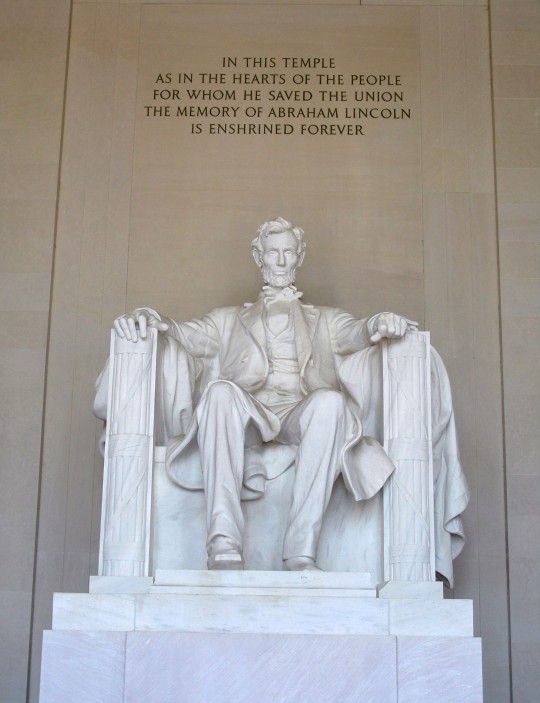
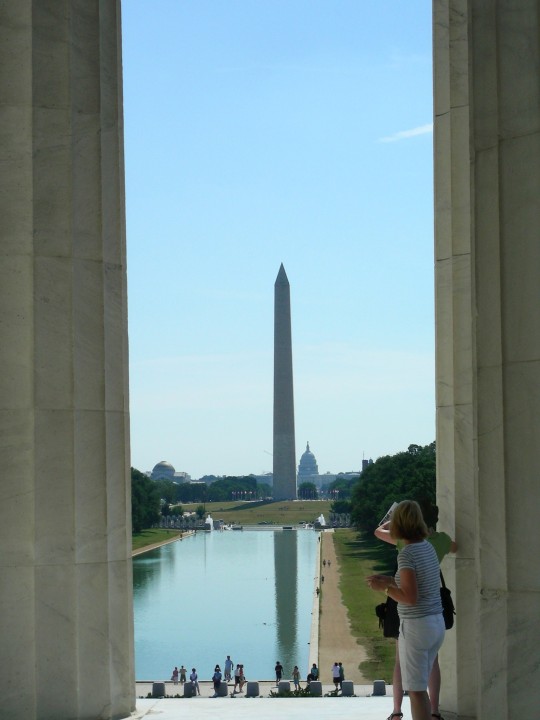



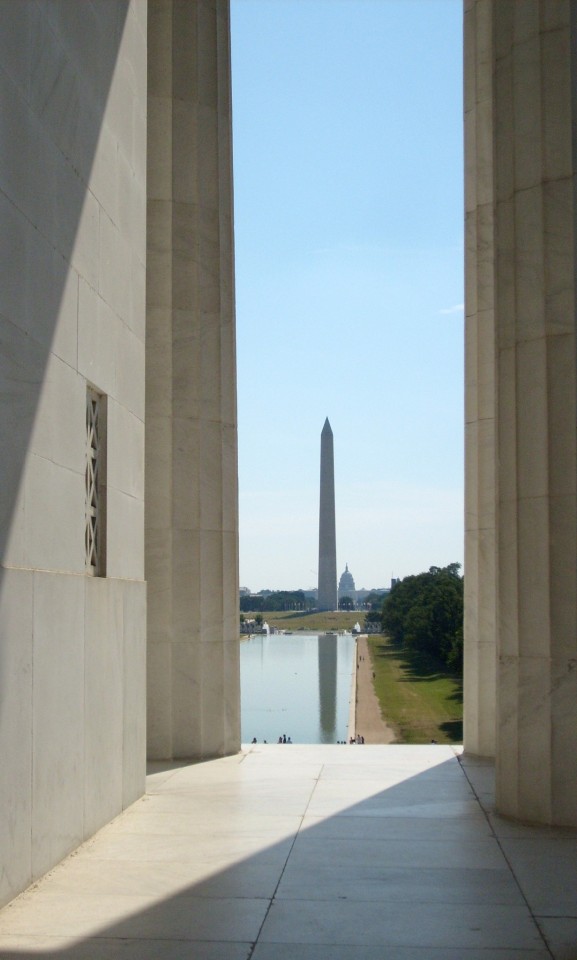
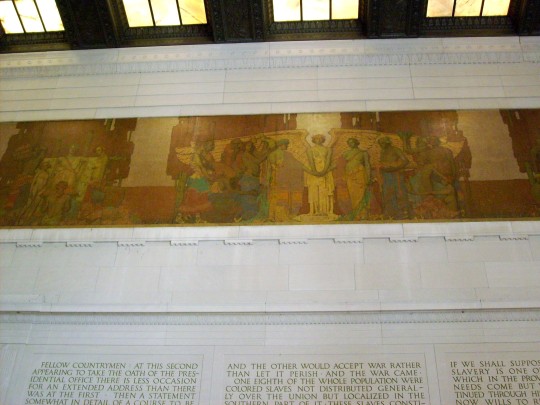

The Lincoln Memorial was dedicated in Washington, D.C. on May 30, 1922.
#Lincoln Memorial#dedicated#30 May 1922#anniversary#US history#USA#Washington Street#summer 2009#Abraham Lincoln#architecture#sculpture#public art#tourist attraction#landmark#cityscape#National Mall#reflecting pool#Henry Bacon#Daniel Chester French#Greek Revival–style#Washington Monument#Gettysburg Address#original photography#Washington DC
8 notes
·
View notes
Photo
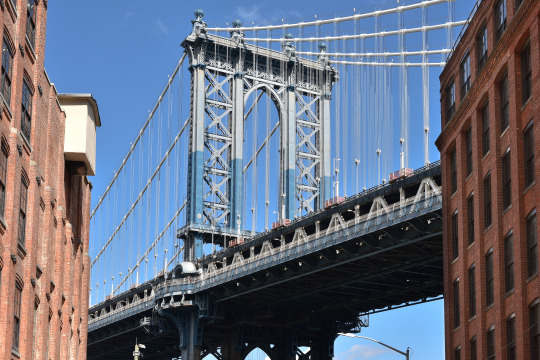
Manhattan Bridge between buildings on Washington Street in Dumbo, Brooklyn
6 notes
·
View notes
Video
Foggy Start by Lester Public Library
Via Flickr:
Two Rivers, Wisconsin
#Two Rivers#Wisconsin#TrueToTwo#Two Rivers Main Street#tree#trees#Street#Washington Street#Downtown Two Rivers#downtown#fog#Explore Two Rivers#Cloudy#winter#January#pavement#buildings#Lester Public Library#WIsconsin#Read#Discover#Connect#Enrich#flickr
2 notes
·
View notes
Photo
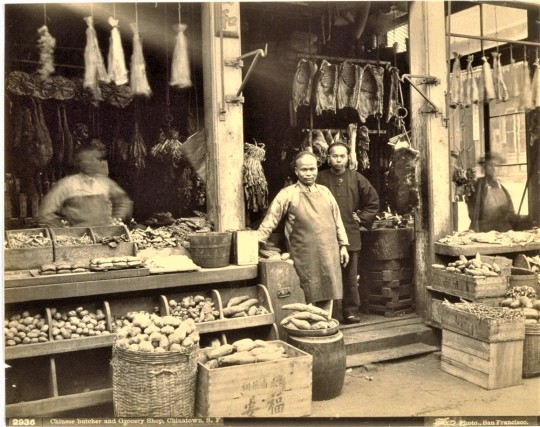
Taber’s Theme and Variations on a Dupont Street Butcher Shop
Before turning to an examination of Isaiah West Taber’s well-known photographs of a San Francisco Chinatown butcher shop, an expression of appreciation for some prior scholarship is in order.
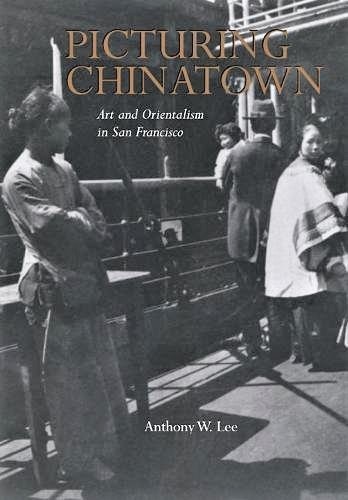
A full two decades have passed since Anthony W. Lee, an art historian, critic, curator and photographer, published a masterwork in the field, Picturing Chinatown Art and Orientalism in San Francisco (University of California Press 2001). In examining the photographic record of San Francisco Chinatown’s first century, from 1850 to 1950, Lee examined more than 160 photographs and paintings from a multi-disciplinary perspective as an art, social and political historian.
In her review of Picturing Chinatown for the Journal of Asian American Studies, Volume 5, Number 2 (Johns Hopkins University Press 2002), Nancy Um wrote about one of Lee’s analysis of Chinatown’s photographs from the 1880’s as follows:
“Lee sets the stage for his inquiry by examining the earliest photographs of Chinatown, dating from the 1850s and the 1860s. He groups early views, which echo the format and the approach of contemporary regional survey photography, with a series of personal posed portraits of the Chinese population, thereby laying the groundwork for understanding the representation of Chinatown as a visual negotiation between an urban landscape and the racialized body.
* * *
“In the second chapter, Lee establishes Chinatown as the arena for the Bohemian flaneur who was preoccupied with the observation and the recording of his urban jaunts. Pivoting on the notion of the picturesque, Lee identifies how the dialectics of Bohemian viewing hinged on the production of a dissimilar Chinese urban landscape. As a contemporary strand, Lee describes how the white working class impulses of the 1870s and 1880s allowed for a parallel, albeit exaggerated construction of the Chinese laborer as the site of opposition, difference, and exclusion. These two narratives serve as a composite example of the ways in which the non-Chinese population of San Francisco used Chinatown as a locus for the construction of their own class and social identities.”
Given this preface, we consider four photographs taken by Isaiah West Taber of perhaps the most famous Chinatown butcher shop of the pre-1906 community. Lee himself writes that “Taber’s photograph of Chinese grocers . . . not only records one proud merchant’s full bins and hooks but also recognizes the new outward display and street orientation of the businesses.” Lee explained Taber’s fascination with Chinese business storefronts as follows:
“Despite the many ordinances designed to push the Chinese out of Chinatown and limit the quarter’s growth, the men did not leave. Only in 1882, when the first exclusion act was passed, would the Chinese be legally forced away. These are grisly actions on the part of politicians needing votes and working classes needing jobs. Without even a thin veneer of legal justification, the ordinances attempted to stifle Chinatown as an economic entity and turn the colony into a stagnant, unproductive zone. They help explain Taber’s continuing interest in Chinatown’s shops, themselves the objects of so much larger attention and hectic legal action.”
Sometime between 1885 and 1887, Taber took a series of four photos of the Cheong Wo & Co. butcher and grocery store at 847 Dupont Street (on the southwest corner of the intersection with Washington Street).

The listing for Chong (a.k.a. Cheong) Wo & Co., as it appeared in the 1882 Directory of Chinese Business Houses published by Wells Fargo Co.
The butcher shop and grocery store held a particular fascination for the historian Lee, which he describes brilliantly and at length as follows:
“The most famous of the four pictures, [no. 2960], reveals the butcher and grocers as solid presences, men whose bodies are as substantial and detailed as the goods they sell. They occupy the openings to their store and stand amid the meats and vegetables that are their business. Taber was careful to catch the strings of hanging meat and peer into the bins of yams and beans, including all the details as a good survey photographer should. He put the men in a portrait-like composition—the outside two flanking the inside two, chins held up, elbows in rhythm. The men’s eyes meet the photographer’s own, directly and unwaveringly. I believe that something of that self-possession and confidence caused Taber to try for different angles and views. . . .

”2936 Chinese butcher and Grocery Shop, Chinatown, S.F.,” no date. (Photograph by Isaiah West Taber (from the collection of the Bancroft Library, University of California at Berkeley). The National Galleries of Scotland asserts that its print of this photograph was created in 1887.
“. . . In the other pictures, he rearranged the men, had them pivot around the central butcher, and pushed them back into the darkness. He opened his lens while the men were in motion, so as to produce blurred figures and unclear faces. He dematerialized the grocer at the far right . . . “

“3140 Chinese butcher and Grocery Shop, Chinatown, S.F.,” c. 1887 (Photograph by Isaiah West Taber (from the collection of the Bancroft Library, University of California at Berkeley).
“. . . and by [photo no. 3140], that man has almost given way to the window and street scene behind. He returned later in the day [photo 3111], when the stock had dwindled and the shop had become less inviting. . . .”
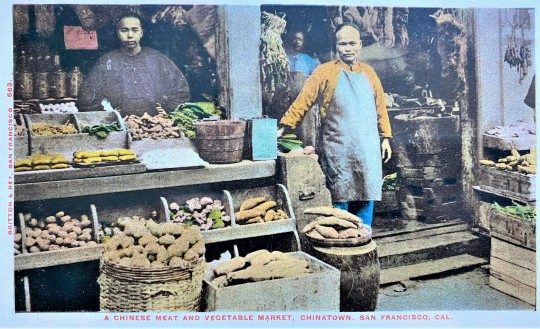
“A Chinese Meat and Vegetable Market, Chinatown, San Francisco, Cal.” Postcard Britton & Rey , San Francisco 563 (from the private collection of Wong Yuen-ming), based on the Taber photo 3140.

“3111 Chinese butcher and Grocery Shop, Chinatown, S.F.,” c. 1887 (Photograph by Isaiah West Taber (from the Marilyn Blaisdell collection of the San Francisco Public Library and the San Francisco Museum of Modern Art).
“He [Taber] moved his tripod to front-center in the manner of the surveyor’s view of the facade, but he pushed the butcher back into the depths, behind a carcass that hid his face. The baskets are empty; the meats that remain seem less choice. The faces of the men are drained of details, and they are much less securely tied to their goods. At the end of the day . . .”
By adjusting the lighting of the image (which I have done above), some additional details of the interior of the shop become visible, the mention of which most archives omit and Lee was no exception (based on the darkened print reproduced in his book). The partially-obscured signage of “. . . ong Wo & co” appears in the store’s interior (above center in the photo) and provided a clue to this writer as to the store’s location.
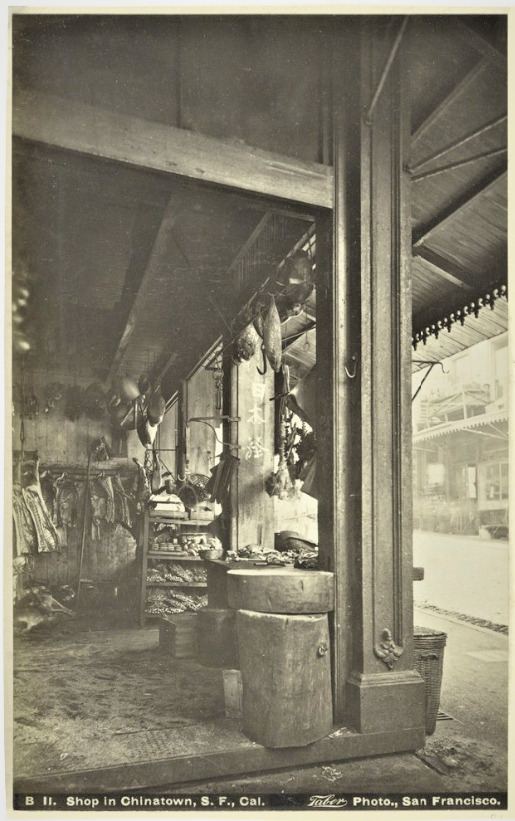
“B 11. Shop in Chinatown, S.F., Cal., c. 1887. Photograph by Isaiah West Taber (from the collection of the San Francisco Museum of Modern Art). The north side of Washington Street, sloping down toward the east, is visible at right.
“Taber returned again [photo B11], but this time he avoided the men completely. He stood inside the shop looking out, approximating the men’s vantage and imaginatively taking over their places. With one part of the picture devoted to the stock and the other to the wide street, he tried to capture what it might be like to own a shop in Chinatown, devoid of the Chinese. . . .”
Lee concluded from Taber’s variations observed in the four-photo series as follows:
“This sequence should not be taken as the pictorial equivalent of the exclusionists’ ordinances. Taber’s view of the Chinese in Chinatown was much more complicated and conflicted than that, caught between the interests of the survey photographer and the portraitist and full of a self-awareness about the effects of his empirical, colonialist gaze (which indeed was related to the exclusionist’s). Working out that relationship, that mode of desire, in photographic terms was his general project, but its pathos and historicity lay in its being structured within the larger, less sympathetic debates about belonging and possession raging around him. The many [anti-Chinese] ordinances gave him ample opportunity to think through the meanings of his own practice in Chinatown.”

Partial detail of “2936 Chinese butcher and Grocery Shop, Chinatown, S.F.,” no date. (Photograph by Isaiah West Taber (from the collection of the Bancroft Library, University of California at Berkeley). Only one character, 和, of the Chinese signage is visible on the left frame of the shop entrance.
Until this article, no writer had bothered to identify the name of the business depicted in Taber’s suite of photos from the mid-1880’s. The omission has been understandable, given the fact that Taber neglected to photograph the entire sign for the business. Only one character, 和, is visible as shown in Taber photos 2936 and 3111.
Fortunately, researchers can thank at least one photographer, and Taber himself, for continued interest in the butcher and grocery shop located on the southwest corner of the intersection of Dupont and Washington Streets.
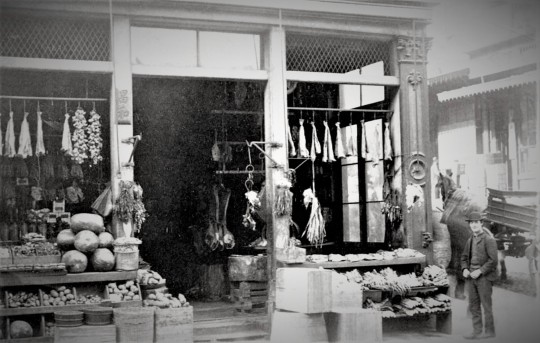
The Cheong Wo butcher shop at 847 Dupont Street, c. 1887-1899. Photographer unknown. On the left side of the door frame a wooden sign bearing two characters 昌和 (canto: “Cheung Woh”) is clearly visible. None of the shop workers appear in the photo.

The Cheong Wo store on the ground floor of the southwest corner of the intersection of Dupont and Washington streets, c. 1887-1899. Photographer unknown (from a private collection). A substantially similar, if not the identical, horse-drawn wagon as shown in the preceding photo appears at right on the Washington Street side of the corner. The double-facing signage for the
泰興 (canto: “Tai Hing”) pawnshop appears at the upper floor corner.
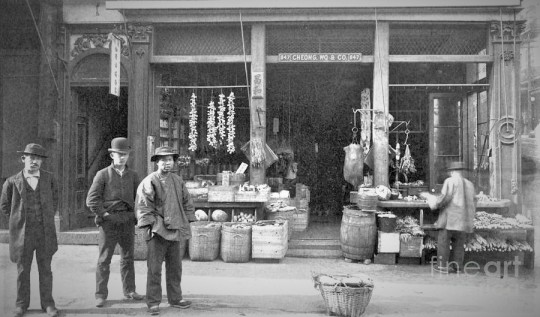
The Cheong Wo & Co. butcher and grocery shop at 847 Dupont Street, c. 1900. Photograph by Isaiah West Taber (from the Bettman Archive).
In or about 1900, Taber returned to that same corner, stood across Dupont Street, and photographed a trio of men standing at the curb in front of the same storefront of his favorite Chinatown butcher and grocery shop. On that occasion, the wooden plaque bearing the two characters 昌和 (canto: “cheung woh”) was clearly visible, still fixed on the upper left frame of the entrance. More important, the street address number and English lettering of the company‘s name appeared above the doorway.

Detail from the July 1885 map published by a special committee of the San Francisco Board of Supervisors (from the Cooper Chow collection of the Chinese Historical Society of America). Based on the data from contemporaneous business directories, the “C[hinese] Meat Store” occupying the 847 Dupont Street address in 1885 was the Cheong Wo & Co.
A cross-check of the address with the business directories of the era discloses that the “Cheong Wo & Co., butchers, 847 Dupont” occupied that address from at least 1879 – 1895.

Three children gather on Dupont Street near the southwestern corner of its intersection with Washington Street, c. 1890′s. Photographer unknown. The Cheong Wo butcher shop can be seen in the background at left. The Grand Chinese Theater can be seen on the north side of Washington Street at right..

The Cheong Wo & Co. at 847 Dupont Street, c. 1890s. Photographer unknown (from the collection of the San Francisco Public Library).

A lantern slide of a customer shopping at probably the Cheong Wo & Co. store based on the partial signage appearing in the upper left-hand corner and the window enframement at the far right of this photo showing a closeup of the storefront. No date. Photographer unknown (from the private collection of Wong Yuen-Ming).
Although the Crocker-Langley directory omitted listings for Chinese businesses, either by neglect or design, in the late 1890’s, the telephone books of 1903 to 1904 indicate that the butcher shop had moved to 712 Dupont sometime around the turn of the century. Thereafter, the pioneer business of Cheong Wo & Co. disappeared from view and passed into history.
However, butcher and grocery operations would continue in the old shop space at 847 Dupont Street. The business known as Sang Wo & Co occupied the corner storefront up to the eve of the 1906 earthquake.

Detail of 1905 Sanborn Map of the southwest corner of Dupont and Washington Streets, showing the continuation of what was by then a quarter-century’s use of the space at 847 Dupont as a meat counter and grocery store.
After Chinatown was rebuilt in the aftermath of the 1906 disaster, the “Sang Wo, Wholesale & Retail Butchers” would resume doing business at the same Chinatown street corner – renumbered as 867 Grant Avenue -- according to the international Chinese business directory of 1913. Perhaps it also served as a symbol to Chinatown’s post-quake residents of the continued vitality of the community’s commerce.

The interior of Sang Wo, c. 1908. (Photographer unknown from the collection of the San Francisco Public Library). The Chinese characters for the company name, 生和 (canto: “Saang Wo”) appear on the large sign seen in the rear of the store. This meat and grocery store reestablished itself at 867 Grant Avenue after the Great Earthquake and continued to do business at the southwest corner of Grant and Washington Streets until 1978.

“Chinese Butcher Shop” c. 1908. Postcard based on the preceding photograph.
[updated 2024-1-1]
#Cheong Wo & Co.#Chinese butcher and grocery store#I.W. Taber#847 Dupont St.#Anthony W. Lee#Picturing Chinatown#Sang Wo#Grand Chinese Theater#Washington Street#Tai Hing pawnshop
6 notes
·
View notes
Text
The 205 to Kent Station
The 205 to Kent Station
A reflection on Washington Street.
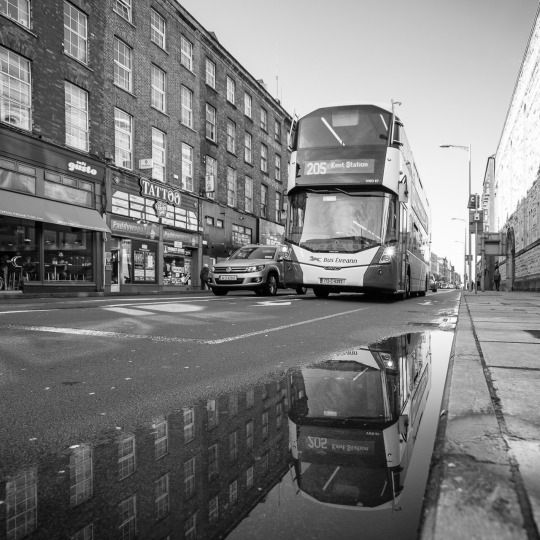
View On WordPress
2 notes
·
View notes
Text
High-visibility Crossing at SE 80th and Stark
On April 18th, crews with Hicks Striping & Curbing began applying high-visibility crosswalks and bike crossings to SE Stark Street at SE 80th Avenue. Workers plan to continue the street painting process one block south on SE Washington, completing this section of the 70s Neighborhood Greenway project. With road markings applied, the Portland Bureau of Transportation (PBOT) can energize…

View On WordPress
#featured#Greenway#Hannah Schafer#Hicks Striping & Curbing#Montavilla Town#PBOT#Stark Street#Washington Street
0 notes
Text
I met her on a Saturday, Washington Street
Those blue eyes cut right through me
She had a flannel on her waist
Her hair was down
And I was just a boy from out of town
The next thing I know I
Was buyin' her a drink
She laughed at my jokes and dance with me
I had two left feet but she didn't care
In that moment we were both right there
But I gave you my heart and
You put me through hell
If I get out I'll have a story to tell
Didn't love you enough then I
Loved you too much
Sometimes you get burned when you're in love
✨,❤️&✌🏼
0 notes
Text
Utility work in downtown Wausau to temporarily close streets
This is expected to be a one-day project.
WAUSAU – Wausau’s Washington Street between First and Fourth streets will be closed for the installation of utilities at the intersection of Third Street and Washington Street beginning Sept. 13, the city announced today.
Additionally, Third Street, between Washington Street and Jefferson Street, will not be accessible to vehicle traffic during this time. Pedestrian traffic will be maintained on…

View On WordPress
0 notes
Text
DVF - Diane Von Furstenburg

Diane Von Furstenburg Portrait in store
Born on December 31st, 1946, Diane Von Furstenburg is a Belgium-born designer that is most well known for her creation of the iconic wrap dresses.
Diane bloomed in the fashion industry as a model, then found her passion in designing. Starting off with basic items, Diane designed t-shirts, shirt dresses, etc. She then created the wrap dress which she debuted with in 1974. Known for their chic look and convenience, to say the least, the wrap dress was a hit! As more women were entering the workforce, it was acceptable for women to start wearing trousers for functional reasons. However, the wrap dress was extremely functional, comfortable, and fashionable. Due to these pros, Diane sold over 5 million wrap dresses in the first few years after its debut.
Diane Von Furstenburg became a role model to many women. Whom looked at Diane for inspiration for fashion related business and even non-fashion related business.
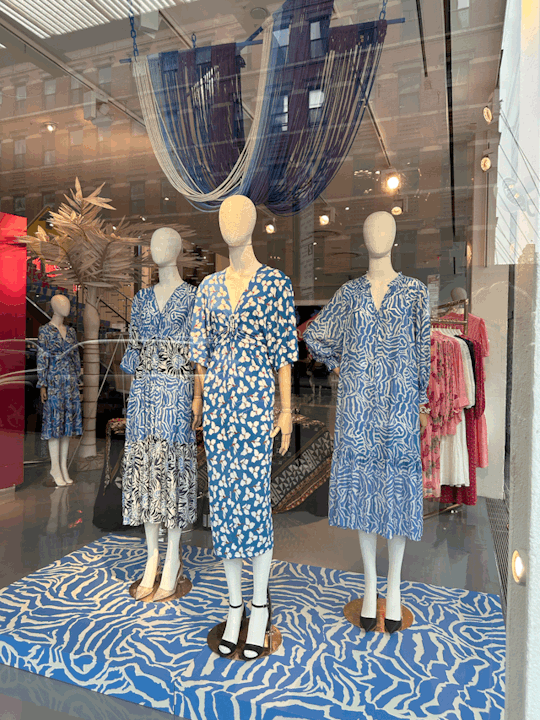
Window display at the DVF store
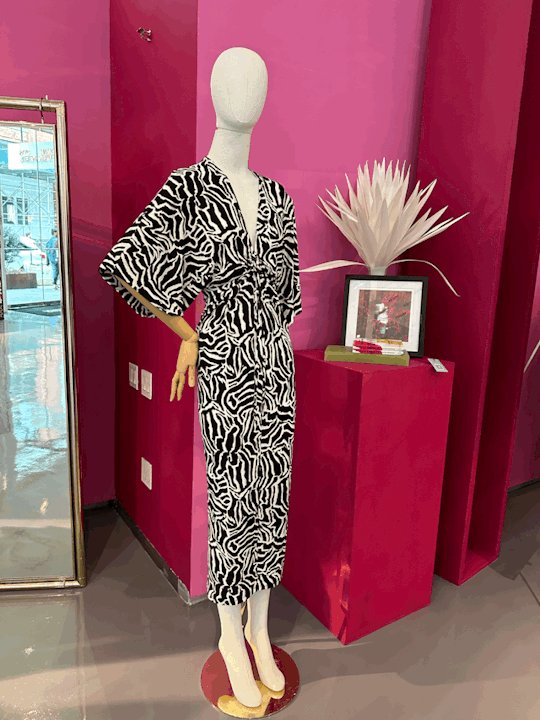
Dress on display in store
The Diane Von Furstenburg store located on Washington st, NYC, had so many iconic dresses and art works on display. As soon as you step foot into the store, you are greeted with so many pieces of art, as well as, a room on the side for live poetry. Even the stairs leading to the second floor of the store was a work of art itself.

Stairs leading to the second floor of the store
Extremely colorful and abstract stairs with neon lights and art pieces posted on the walls. Additionally, inside the store, there was a photo booth for anyone to stop by and take pictures. The mirrors and displays inside were unbeatable.

On the left is the Photo Booth.

Footwear display
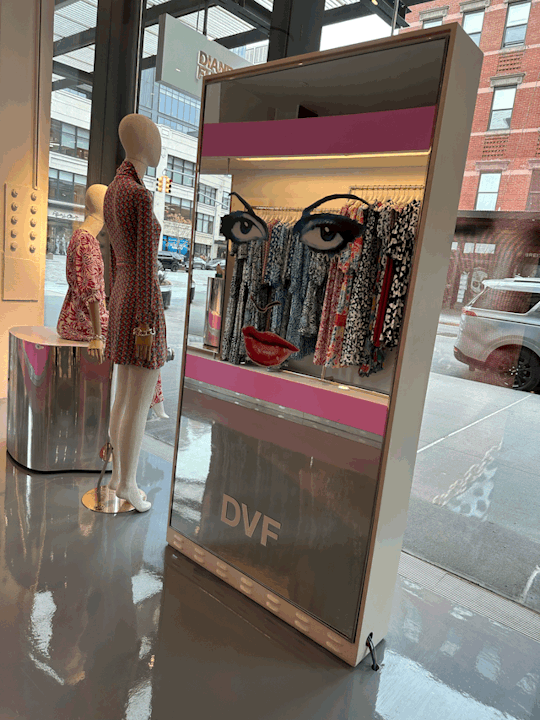
One of the mirrors inside
There was a very interesting thing in the DVF store that I would have never expected.
Projector projecting Virtual Fashion
It was very interesting to see snippets of these virtual fashion shows that were being projecting inside of the store. There was an employee monitoring the projectors and changing up the clips from time to time.
I really enjoyed my visit at the DVF store. There was so much that caught my eye and made me think,
"I would love this in my room..."
From the dresses on the mannequins to the works of art posted on the wall, everything was so unique and aesthetically pleasing. Thinking my visit would only last a few minutes, I was prepared to snap a few shots and head out, but I stayed in the store for about 20 minutes just really appreciating the layout and the art that the DVF store is.
I would love to visit again to try out the photo booth, or maybe treat myself to an iconic Diane Von Furstenburg wrap dress one day.


More artworks that were displayed inside
#wrap dress#art#diane von furstenberg#washington street#fashion#live poetry#abstract art#photobooth#nyc#icon
0 notes
Text

Tilly, 16
“I’m wearing a Mobile Gundam Suit graphic tee, fishnet gloves with ribbons, a skirt from HOTTOPIC that buttons at the front, grommet belt with a chain, spider web fishnets with garters, Doc Martens, black and striped knee socks, and my 3-ringed choker with a patch attached to it. And a lot inspires my style since I’m not totally done improving my wardrobe. I take a lot of influence from various j-fashion magazines and subcultures.“
Aug 22, 2023 ∙ Greenwich Village
#nyc looks#street style#new york#street fashion#style#outfit#thrifted#band tshirt#band tee#washington square park
730 notes
·
View notes
Photo

Johnson County Savings Bank, Iowa City, Iowa, between 1915 and 1920
Creator: Kent, Frederick W.
Corner of Clinton and Washington streets, looking southeast. Banner hanging over Clinton Street reads "Basketball -- Iowa Wesleyan (Mt. Pleasant) vs. Iowa -- Monday".
https://digital.lib.uiowa.edu/islandora/object/ui%3Aictcs_692
4 notes
·
View notes
Photo
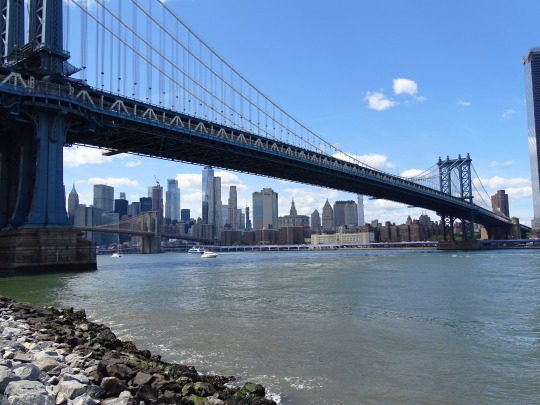


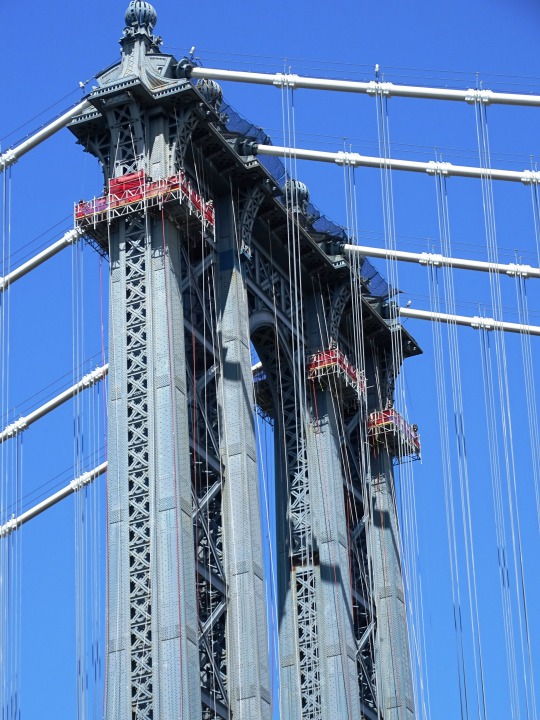

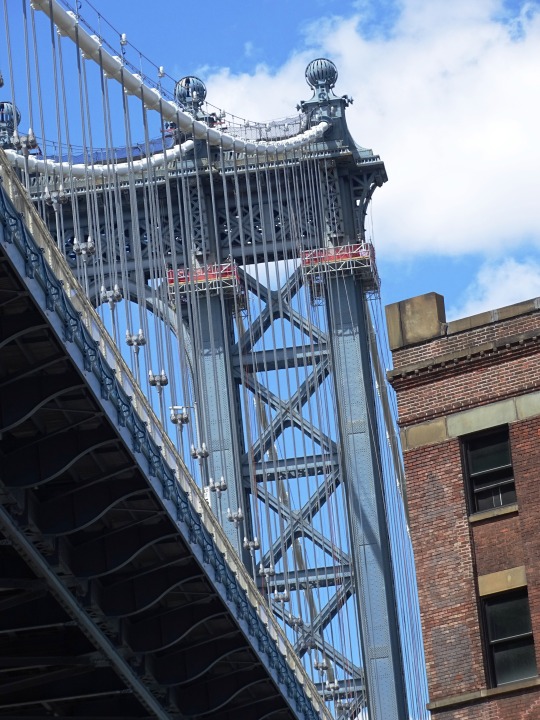


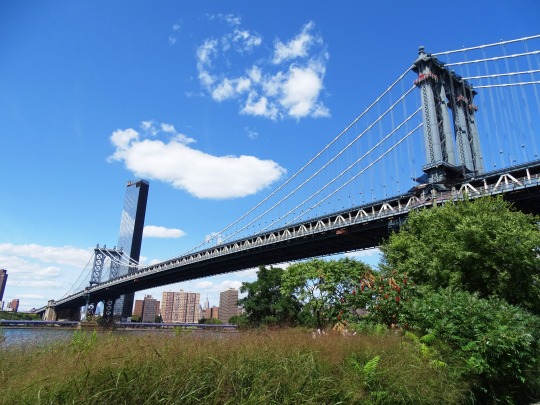

The Manhattan Bridge opened to traffic on December 31, 1909
#Washington Street#Manhattan Bridge#Leon Solomon Moisseiff#architecture#Othniel Foster Nichols#opened#31 December 1909#original photography#anniversary#US history#DUMBO#Brooklyn#New York City#Manhattan#summer 2019#tourist attraction#landmark#East River#skyline#vacation#Brooklyn Bridge#Empire State Building
2 notes
·
View notes
Text
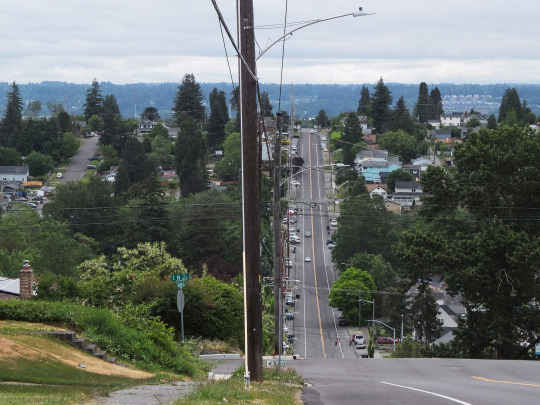

Tacoma, Washington. (May 2021)
154 notes
·
View notes
Video
16th and Washington by Lester Public Library
Via Flickr:
Two Rivers, Wisconsin
#Two Rivers#Wisconsin#Washington Street#16th Street#Schroeder's#Schroeder's Department Store#steeple#Downtown Two Rivers#downtown#afternoon#Summer#sunny#TrueToTwo#Explore Two Rivers#Street#trees#tree#September#Lester Public Library#WIsconsin#Read#Discover#Connect#Enrich#flickr
3 notes
·
View notes

